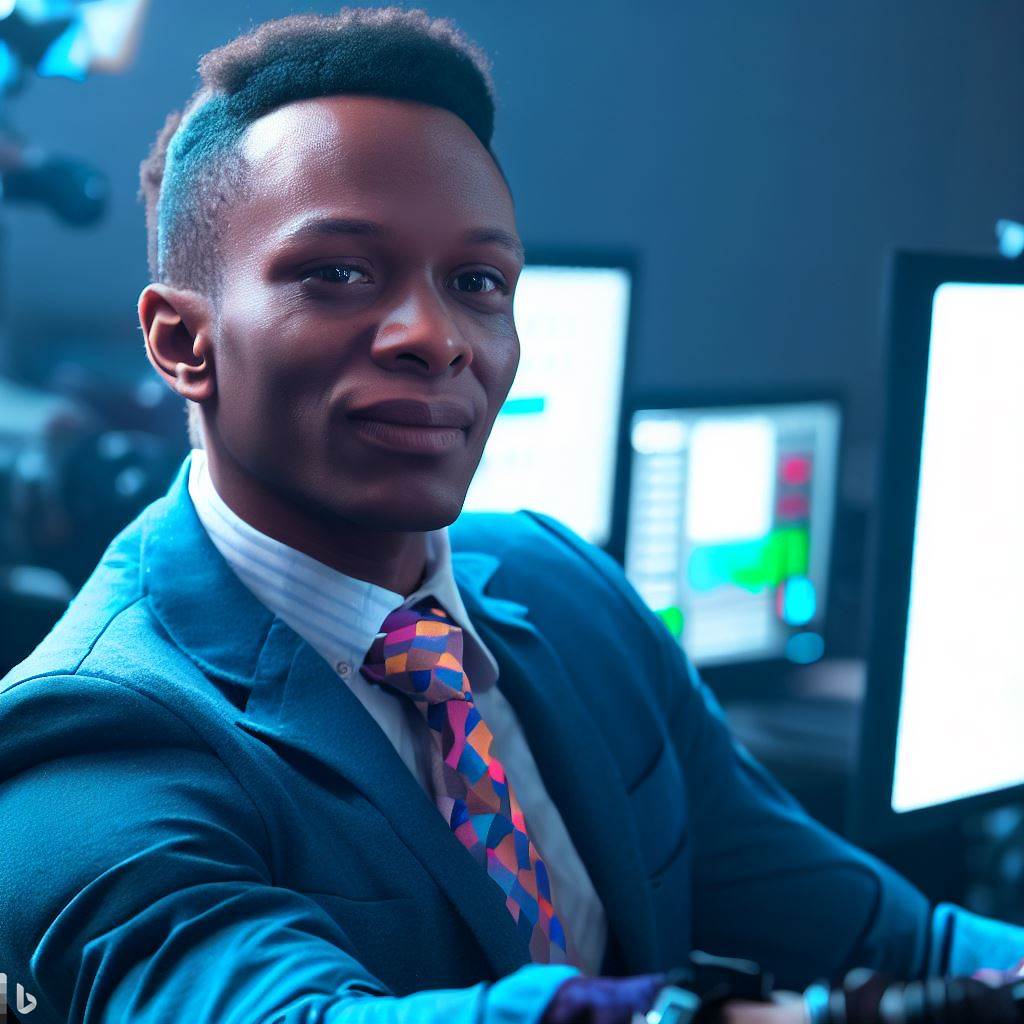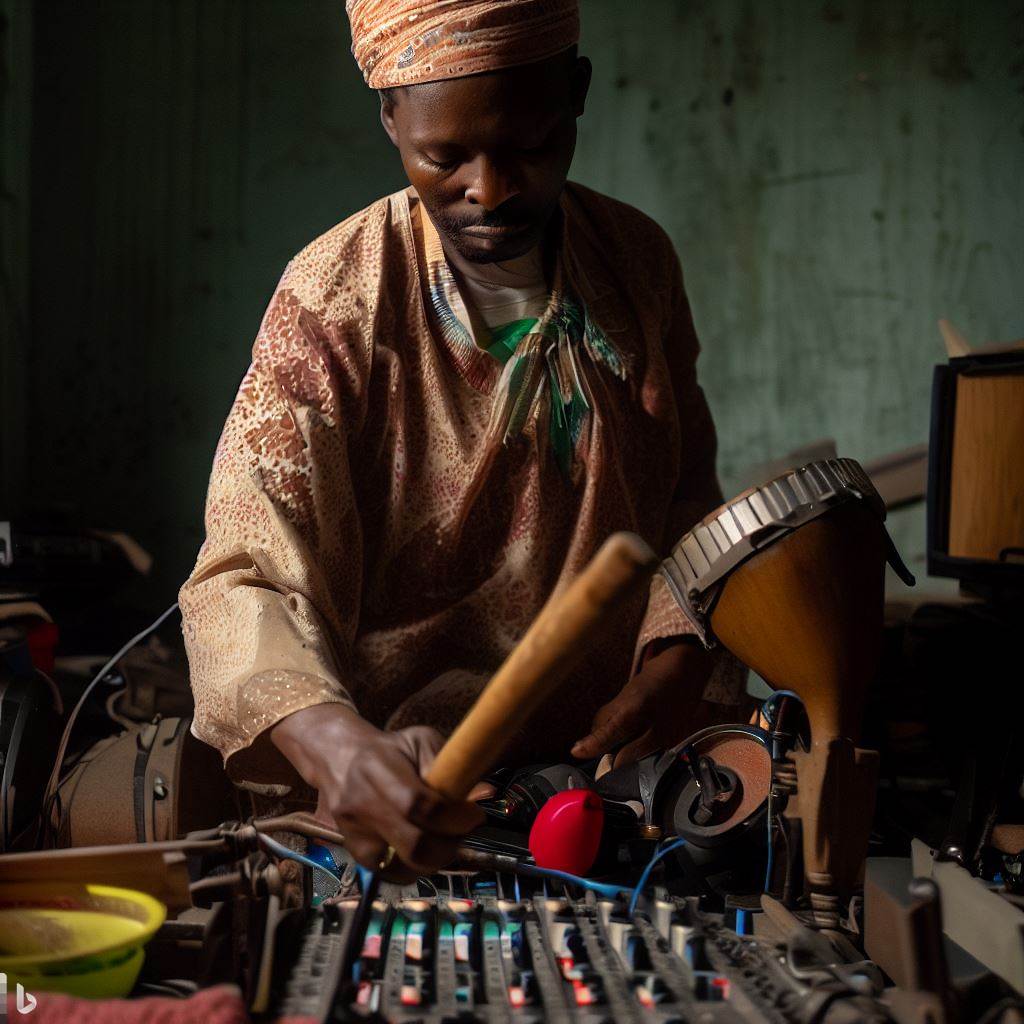Introduction
Being an animation director in Nigeria requires creativity, patience, and dedication to the craft. Each day is filled with unique challenges and exciting opportunities to bring stories to life.
This blog post will provide a glimpse into the world of a Nigerian animation director, exploring their daily routine, responsibilities, and the impact of their work.
The purpose of this post is to showcase the hard work and talent that goes into creating animations in Nigeria.
By shining a spotlight on the role of an animation director, readers will gain a deeper appreciation for the art form and the individuals behind it.
Furthermore, this blog aims to inspire aspiring Nigerian animators and encourage them to pursue their dreams in the field.
From the early morning hours, a Nigerian animation director kicks off their day by reviewing storyboard sketches, ensuring that the visuals align with the script.
With a critical eye for detail, they provide feedback to the storyboard artists, refining the visuals to match the desired aesthetic.
Collaboration is key in the animation industry, and a director spends a significant portion of their day working closely with animators, character designers, and sound engineers.
They guide the team, ensuring that the animation is fluid, the characters are captivating, and the sound effects enhance the overall experience.
As the day progresses, the director engages in meetings with clients, discussing project timelines, and presenting ideas for upcoming animations.
They must showcase their vision and demonstrate their understanding of the client’s needs, while also incorporating their own creative expertise.
While the director’s day is filled with meetings and creative decision-making, they also allocate time to review ongoing projects.
They carefully analyze the animation sequences, looking for opportunities to improve, add polish, or make adjustments that enhance the storytelling.
The blog concludes by emphasizing the immense dedication and passion required to succeed as a Nigerian animation director.
It encourages readers to support and appreciate the work of these talented individuals who bring joy and entertainment to audiences worldwide.
Background of the Nigerian Animation Industry
Overview of the Nigerian animation industry
The Nigerian animation industry is a vibrant and growing sector within the country’s entertainment industry.
It encompasses various forms of animation, including traditional hand-drawn animation, 2D and 3D computer animation, and stop-motion animation.
Nigerian animators create content for television, film, advertising, and digital platforms.
There is a growing interest in Nigerian animation both domestically and internationally, leading to more opportunities for animators.
The industry faces challenges such as limited infrastructure, funding, and piracy, but it continues to thrive due to the passion and creativity of Nigerian animators.
Growth and development of animation in Nigeria
The history of animation in Nigeria can be traced back to the early 2000s.
Initially, animation was mainly used for educational and advertising purposes, with limited exposure in mainstream media.
However, with technological advancements and the rise of digital platforms, the demand for animated content has increased.
Nigerian animators have embraced these opportunities and have contributed to the growth of the industry.
They have gained recognition both locally and internationally, with Nigerian animated series and films receiving awards and nominations.
Government initiatives and collaborations with international studios have also played a role in fostering the growth of animation in Nigeria.
Animation studios have emerged across the country, providing employment opportunities for talented animators.
Additionally, animation festivals and events have been organized to showcase and promote Nigerian animation.
The industry has also benefited from the growing appreciation of African content globally, leading to more collaborations and partnerships.
Overall, the growth and development of animation in Nigeria has been remarkable and continue to hold immense potential for the future.
Read: The Journey to Become an Animation Director in Nigeria
Definition and Role of an Animation Director
Defining what an animation director does
An animation director is the creative leader responsible for overseeing and managing the entire animation production process.
They collaborate with various teams to develop and execute the artistic vision of a project. Their role involves planning, directing, and supervising the animation team to ensure the desired outcome is achieved.
They possess a deep understanding of animation techniques, storytelling, and visual aesthetics.
Responsibilities and duties of an animation director
- Creating and maintaining the project’s artistic vision and style throughout the production.
- Collaborating with writers, artists, and animators to develop storyboards and conceptualize ideas.
- Providing guidance and feedback to the team on character design, animation techniques, and overall quality.
- Ensuring that the animation production adheres to the project’s timeline and budget constraints.
- Overseeing the hiring and training process of the animation team.
- Conducting regular meetings and reviews to assess progress, address issues, and make adjustments as needed.
The significance of their role in the industry
- An animation director plays a crucial role in determining the success and quality of an animated project.
- They bring the artistic vision and conceptual ideas to life, captivating audiences with compelling storytelling.
- Their expertise and leadership contribute to the overall production value and aesthetic appeal of the animation.
- Animation directors are instrumental in fostering collaboration and ensuring a cohesive creative process.
- Their guidance and mentorship inspire the team to excel and deliver outstanding results.
- They also have a significant impact on the industry’s growth by pushing boundaries, innovating techniques, and setting new standards.
- Animation directors are responsible for shaping the future of animation through their artistic vision and direction.
In the end, an animation director is a creative leader with a vital role in the animation industry. They define and execute the artistic vision, supervise the production process, and guide the animation team.
Their expertise and leadership contribute to the success and quality of animated projects, as well as the industry’s growth and innovation.
Read: Impact of Social Media on Copywriting in Nigeria
Morning Routine
The typical morning routine of a Nigerian animation director
In Nigeria, a typical morning routine for an animation director entails a series of organized activities that set the pace for the day.
- Wake Up: The director rises early in the morning, typically around 6:00 am, to start their day.
- Exercise: They engage in physical activities like jogging or yoga to stay healthy and improve focus.
- Breakfast: A nutritious meal, often consisting of fruits, cereals, and fresh juices, provides the necessary energy.
- Review Schedule: The director checks their calendar to stay updated on upcoming meetings and deadlines.
- Reply to Emails: They go through their inbox, responding to important messages and prioritizing tasks.
Tasks and activities they undertake at the start of their day
At the beginning of their day, Nigerian animation directors engage in various tasks and activities to ensure a productive start.
- Team Meetings: They gather with their animation team, discussing ongoing projects, and addressing any concerns.
- Planning: The director maps out the day, creating a to-do list and allocating time for specific tasks.
- Creative Sessions: They brainstorm ideas, provide feedback, and collaborate with animators and designers.
- Script Review: If working on a new project, the director analyzes scripts, offering suggestions for improvement.
- Production Planning: They coordinate with other departments, such as sound engineers and voice actors, to ensure seamless collaboration.
- Project Research: Nigerian animation directors stay updated with industry trends and study techniques to enhance their skills.
- Budget Management: They review financial aspects, ensuring resources are allocated appropriately for each project.
- Client Communication: Directors interact with clients, keeping them informed about progress and addressing any concerns.
Read: Leveraging SEO in Copywriting: A Guide for Nigerians
Pre-production Phase
Pre-production is a crucial step in the animation process, as it sets the foundation for a successful project.
During this phase, the animation director engages in various activities while collaborating with the production team.
Importance of Pre-production in Animation
- Allows time for brainstorming and developing a solid concept for the animation.
- Helps in creating a detailed storyboard, which serves as a blueprint for the animation.
- Provides an opportunity to identify and address any potential issues or challenges early on.
- Allows for efficient allocation of resources, including time, budget, and talent.
- Ensures that all parties involved have a clear understanding of the project’s goals and objectives.
Activities of an Animation Director during Pre-production
- Collaborating closely with the scriptwriters to develop a compelling and engaging story.
- Working with the art director to establish the visual style and design elements of the animation.
- Creating a storyboard to visualize the sequence of shots and plan the animation’s pacing and timing.
- Conducting research on the subject matter or style to ensure accuracy and authenticity in the animation.
- Identifying and sourcing voice actors or recording artists for any dialogue or music requirements.
Collaboration Process with the Production Team
- Regularly communicating and meeting with the production team to discuss progress and exchange ideas.
- Seeking input and feedback from team members to enhance the overall quality of the animation.
- Coordinating with the character designers, animators, and visual effects artists to ensure consistency.
- Collaboratively deciding on the color palette, lighting, and background elements of each scene.
- Working closely with the sound designers and composers to synchronize sound effects and music with the animation.
Overall, the pre-production phase of animation is a collaborative and vital part of the creative process.
It allows the animation director to lay a strong foundation for the project, ensuring that all aspects from storytelling to visual design are carefully planned and executed.
By engaging in activities such as concept development, storyboarding, and collaboration with the production team, the animation director sets the stage for a successful animation project.
Read: Education and Courses for Aspiring Copywriters in Nigeria

Production Phase
Activities carried out by an animation director during production
- Collaborating with the animation team to establish the overall vision and style of the project.
- Developing storyboards and animatics to guide the animation process.
- Overseeing the creation of character designs, background art, and other visual elements.
- Providing clear direction and feedback to animators to ensure consistency and quality.
- Reviewing and approving animation drafts and final renders.
- Working closely with the sound department to synchronize sound and visuals.
- Managing production schedules and deadlines to ensure timely delivery of the project.
- Communicating with clients or producers to address any concerns or changes during production.
- Maintaining a high level of creativity and attention to detail throughout the production process.
Supervisory role of an animation director in coordinating the animation team
- Assigning specific tasks to each member of the animation team based on their skills and expertise.
- Conducting regular team meetings to discuss progress, challenges, and potential solutions.
- Providing guidance and mentorship to junior animators to nurture their growth and development.
- Ensuring effective communication and collaboration among team members.
- Monitoring the workflow and productivity of the animation team to maintain efficiency.
- Addressing conflicts or issues within the team to maintain a healthy and productive work environment.
- Collaborating with other departments, such as the art department and post-production team, to coordinate efforts smoothly.
Challenges and problem-solving skills required during production
- Managing and balancing the creative demands of the project with practical constraints and limitations.
- Dealing with unexpected technical issues or software glitches that may arise during the animation process.
- Adapting to changes or revisions requested by clients or producers while maintaining the project’s integrity.
- Solving creative problems, such as finding innovative ways to visualize complex concepts or scenes.
- Motivating and inspiring the animation team during challenging or demanding periods of production.
- Finding efficient solutions to meet tight deadlines without compromising quality.
- Collaborating with the team to brainstorm and implement creative solutions to overcome production obstacles.
- Ensuring effective communication and coordination between different departments or individuals involved in the project.
In short, the production phase of an animation project is a crucial stage where the animation director plays a vital role.
They are responsible for overseeing various activities, collaborating with the animation team, and solving challenges that may arise during production.
With their supervisory role and problem-solving skills, the animation director ensures the smooth coordination and timely delivery of a high-quality animated project.
Post-production Phase
Final Touches
After the animation is complete, the director adds the final touches to enhance the project’s overall quality and appeal.
Collaboration with Audio, Visual Effects, and Editing Teams
The director closely works with audio, visual effects, and editing teams to ensure seamless integration of all elements.
Attention to Detail and Quality Control
The post-production phase demands meticulous attention to detail and strict quality control measures to deliver a refined final product.
Learn More: The Financial Side of Artist Management in Nigeria
Market and Distribution
Challenges faced by Nigerian animation directors in marketing and distribution
Nigerian animation directors face numerous challenges in marketing and distributing their work.
- Limited funding and resources make it difficult to reach a wider audience.
- Low awareness and appreciation for animation as an art form hinders market growth.
- Inadequate infrastructure and distribution networks make it challenging to distribute animated projects.
- Piracy and copyright infringement pose significant threats to the profitability of Nigerian animated content.
Strategies used to promote their work and reach a wider audience
Despite these challenges, Nigerian animation directors employ various strategies to promote their work and reach a wider audience.
- Building a strong online presence through social media platforms and their own websites.
- Participating in local and international animation festivals and competitions to gain exposure.
- Collaborating with established brands or companies to leverage their existing marketing and distribution networks.
- Engaging in targeted marketing campaigns that specifically highlight the unique cultural elements of Nigerian animation.
- Creating partnerships with local theaters or television networks to showcase their animated content.
Examples of successful Nigerian animated projects
Several Nigerian animated projects have achieved success both locally and internationally.
- “Oba’s Elephants” directed by Ema Edosio is a critically acclaimed animated short film that received various awards.
- “Malika: Warrior Queen” directed by Roye Okupe is a popular web series with a growing fanbase.
- “The Secret Princess” directed by Segun Williams gained international recognition and distribution.
- “Bino and Fino” by Adamu Waziri is a successful children’s animated series that promotes African culture.
- “Gidi Up” directed by Jadesola Osiberu combines animation and live-action to tell compelling stories.
In a nutshell, Nigerian animation directors face significant challenges in marketing and distributing their work due to limited funding, low awareness, infrastructure issues, piracy, and lack of industry platforms.
However, they employ various strategies such as online presence, festival participation, collaborations, targeted marketing, and partnerships to promote their work.
Some Nigerian animated projects have achieved success both locally and internationally, showcasing the immense talent and potential of Nigerian animators.
Gain More Insights: The Role of Managers in Nurturing New Nigerian Talent
Personal Reflections and Achievements
Personal experiences of a Nigerian animation director
Starting my journey as a Nigerian animation director was both challenging and exhilarating. From a young age, I was fascinated by animated films and had a strong desire to create my own.
I pursued a degree in animation, which provided me with the necessary technical skills and knowledge.
Throughout my career, I have had the opportunity to work on various projects, both locally and internationally.
Collaborating with talented artists and professionals has been a great learning experience. As a Nigerian animation director, I have faced unique challenges, such as limited resources and funding.
However, these challenges have only fueled my determination to overcome obstacles and produce high-quality animations.
One of my most memorable experiences was directing a short film that won several awards at international film festivals.
This recognition not only brought attention to my work but also highlighted the potential of Nigerian animators.
Overall, my personal experiences as an animation director have been filled with both growth and fulfillment.
Achievements in the industry
Throughout my career, I have achieved several milestones that have propelled me forward in the animation industry. I have successfully directed and released numerous animated films and television series.
One of my greatest achievements was establishing my own animation studio, which has become a hub for local talent. Our studio has produced groundbreaking animations that have garnered international acclaim.
I have also been recognized for my contributions to the industry through awards and nominations.
These achievements not only validate my hard work but also inspire me to continue pushing boundaries in animation.
Furthermore, I have had the privilege of mentoring aspiring animators and fostering growth within the industry. Seeing their progress and passion for animation motivates me to continue striving for excellence.
Overall, my achievements have allowed me to establish a strong presence as a Nigerian animation director. I am proud of the impact I have made and excited for what the future holds in this dynamic field.
Their passion for animation and future aspirations
My passion for animation has been the driving force behind my career as a Nigerian animation director. Animation has the power to captivate audiences and tell stories that can transcend cultural boundaries.
It allows me to bring my imagination to life and create characters that resonate with people. Looking towards the future, I aspire to continue pushing the boundaries of animation in Nigeria.
I aim to collaborate with international studios and create more opportunities for Nigerian animators.
Additionally, I am keen on using animation as a medium to address social issues and promote positive change.
Through my work, I hope to inspire the next generation of Nigerian animators and showcase our talents on a global scale.
Ultimately, my passion for animation will continue to drive me towards achieving new heights of creativity and artistic expression.
Conclusion
In this blog post, we discussed the day-to-day life of a Nigerian animation director. Nigerian animation directors play a crucial role in the growth and success of the industry.
Main Points Recap:
- Creative Process: Explored the multifaceted tasks, from storyboarding to supervising animation production.
- Collaborative Efforts: Highlighted teamwork with animators, sound engineers, and writers for seamless projects.
- Innovative Vision: Discussed how directors infuse unique styles and cultural elements into animations.
Role in Industry Growth:
- Driving Force: Animation directors steer Nigerian animation toward international acclaim, fostering industry growth.
- Cultural Representation: Directors integrate local stories, characters, and settings, promoting Nigeria’s cultural diversity.
- Skills Development: Inspire the next generation by showcasing the potential of animation as a viable career.
Embrace Nigerian Animation:
Uncover the world of Nigerian animation. Support directors’ contributions and savor the richness of local storytelling.
We encourage readers to explore and support Nigerian animation, as it has great potential.




